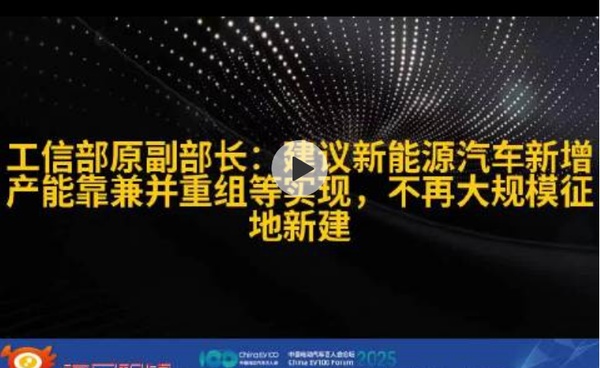Former Vice Minister of the Ministry of Industry and Information Technology: It is recommended that new production capacity for new energy vehicles be achieved through mergers, acquisitions, and other means, instead of large-scale land acquisition and new construction.
The China EV100 Forum (2025) was held in Beijing from March 28 to March 30. Su Bo, former Vice Minister of the Ministry of Industry and Information Technology, stated that China is currently at a critical turning point in the transition from oil to electricity, and it is urgent to promote the full utilization of fuel vehicle resources.

"In the next two to three years, it will still be a period of rapid development for new energy vehicles, as well as a painful transition phase from oil to electricity," he said, adding that China's automotive industry will enter a new stage where new energy vehicles dominate market development.
However, he emphasized that currently, there are at least over 30 million units of fuel vehicle capacity and over 20 million units of established new energy vehicle capacity. The oil-to-electric conversion has only absorbed two to three million units of fuel vehicle capacity, while most of the new energy vehicle capacity is newly built. At present, the production and sales of fuel vehicles and their profitability have significantly declined, with a large amount of capacity being left idle, facing a major crisis of survival. Some enterprises have already stopped production or gone bankrupt.
Su Bo pointed out that market demand has become the main driver determining the speed and fate of the transition from quantitative to qualitative change in fuel vehicles, making the restructuring of the automotive industry ecosystem urgent. He suggested that relevant authorities should quickly research and formulate policies for guidance and leadership, while vigorously promoting the acceleration of the electrification transformation of fuel vehicle companies. Furthermore, he recommended that new production capacity for new energy vehicles be primarily achieved through mergers and reorganizations of fuel vehicle companies, shareholding reform, and asset acquisitions, rather than large-scale land acquisition for new construction, in order to reduce the potential for greater resource waste that may arise from continuing parallel development.
【Copyright and Disclaimer】The above information is collected and organized by PlastMatch. The copyright belongs to the original author. This article is reprinted for the purpose of providing more information, and it does not imply that PlastMatch endorses the views expressed in the article or guarantees its accuracy. If there are any errors in the source attribution or if your legitimate rights have been infringed, please contact us, and we will promptly correct or remove the content. If other media, websites, or individuals use the aforementioned content, they must clearly indicate the original source and origin of the work and assume legal responsibility on their own.
Most Popular
-

List Released! Mexico Announces 50% Tariff On 1,371 China Product Categories
-

Nissan Cuts Production of New Leaf EV in Half Due to Battery Shortage
-

New Breakthrough in Domestic Adiponitrile! Observing the Rise of China's Nylon Industry Chain from Tianchen Qixiang's Production
-

Dow, Wanhua, Huntsman Intensively Raise Prices! Who Controls the Global MDI Prices?
-

Mexico officially imposes tariffs on 1,400 chinese products, with rates up to 50%






